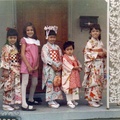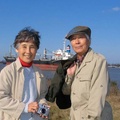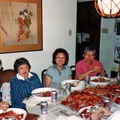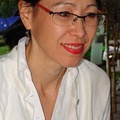Japanese and Japanese Americans are certainly a minority in Louisiana, but are nevertheless a viable and tight-knit community. Numbering in the hundreds, families generally lived peacefully next to their non-Japanese neighbors, and joined together during special occasions such as New Year's or Children's Day. Even during difficult times, families would help one another both financially and emotionally. In contrast to the Nikkei of the West Coast, they rarely encountered discrimination even during the post-War years when they tried to piece their lives back together.
Before the Second World War, a handful of especially adventurous families had moved eastward and sparsely populated the small towns of Louisiana. Many started small businesses selling produce or dry goods, and lived harmoniously amongst their Cajun neighbors. A Japanese consulate was first appointed as early as 1897 in order to stimulate trade between the nations, particularly since New Orleans was a port city to the cotton industry.1
There was also increased interest in Japanese arts and crafts with the US and other Western nations. Hyuga Tomematsu opened a Japanese craft shop, while Mr. Katagiri ran an inn and restaurant for Japanese sailors. There were also a few Japanese shrimp fisherman who lived in the region prior to the outbreak of World War II. However, after the US declared war on Japan, many were forced to leave New Orleans and never returned. The consulate offices were closed as well.
Nevertheless, Japanese living in California at the time moved to the West Bank of the Mississippi River in New Orleans to avoid the anti-Japanese sentiment on the West Coast. In contrast to West Coast Nikkei communities, there was actually little contact between Nikkei given the geographical distance between family homes, although everyone seemed to know one another.
One such Cajun Nikkei, Mr. Joe Nagata,2 a Nisei born and raised in rural Louisiana, never experienced any of the animosities of his counterparts on the West Coast. Even during the early War years, his neighbors understood that even though the US was at war with Japan, the Nagatas were Americans. Perhaps the Cajuns could easily understand this because they had come from a history of persecution themselves.
Although the FBI did investigate his family's produce business, they (the FBI) apologized profusely for the intrusion. Nagata eventually attended college at Louisiana State University where he played football, and helped lead the team to a 1944 Orange Bowl victory. Shortly after, however, he was called to serve in the famed 442nd regiment in Europe, where he, along with other Nisei soldiers, fought in Italy's Po River Valley.
Shortly after World War II, the War Relocation Authority set up an office in New Orleans, and a few Japanese American families arrived from the internment camps.3 Records indicated that at least 15 families had moved from the camps to New Orleans: Daisuke Yenari, Mitsugu Fujita, Tomematsu Hyuga, Seiji Hirami, Asaichi Hieshima, Hideko Ijuin, Masaru Imahara, Tetsuo Iwai, Kango Izumi, Yamato Kikuchi, Tsukasa Yonetani, Kotaro Kunii, Masayoshi Masuda, Tsutomu Miyake, Hatsuko Nasu, Yajuro Nukui, Koji Okubo, Uichiro Sagawa, Tsuruichi Sasaki, Kyokuzo Tomoda and Hata.7 They were given only $25 per person to start all over again, and to not return to the West Coast. Many lived there for a few years until they had means to return to California.
However, a handful of families remained because they fell in love with the swamplands of Louisiana, and the Old World charm of New Orleans. The 1950s would be a time when the Japanese-Americans would try to piece their lives back together after the difficult war years. By 1952, a Japanese consul general was re-established along with a Japan Society of New Orleans in order to foster trade and better relations between the two countries.
During the 1960s and 1970s, more Japanese came to New Orleans and the community grew. Many were academics, diplomats and businessmen and would only spend a few years in the U.S., then move on to their next assignment. Those who made Louisiana their permanent home would form a core of families who organized social events such as bonenkai (loosely, farewell old year, hello new), an annual sukiyaki dinner, a Children's Day picnic and even a crawfish boil where Louisiana seafood would be served along with Japanese dishes such as makizushi and teriyaki. The central social event would be a large New Year's party held at the Consul General's home.
These families also served as a kind of anchor for newer Japanese families who would come to New Orleans, because they served as a bridge between Japanese and American cultures and language. Soon it became clear that the Japanese and Japanese Americans needed a social network, and by 1974, the Japan Club of New Orleans was founded.
As the Japanese economy went into a slump in the 1990s, so did immigration to New Orleans. A constant community remained, but many of the Nisei and Sansei children, now quite assimilated into mainstream American culture, went on to higher education, some attaining advanced degrees. Many moved away from New Orleans to pursue their professional dreams.
Then, in 2005, hurricane Katrina hit the Gulf Coast, and devastated the Greater New Orleans area with flooding due to levee breaks. Residents throughout the city were displaced for months, and some never returned. As New Orleans struggled to recover from this disaster, the Japanese community was affected as well. The Japanese government decided to close its New Orleans office in 2007, and Oriental Merchandise, the oldest Japanese market in the area and a central meeting place for many Nikkei, shuttered its doors in 2009.
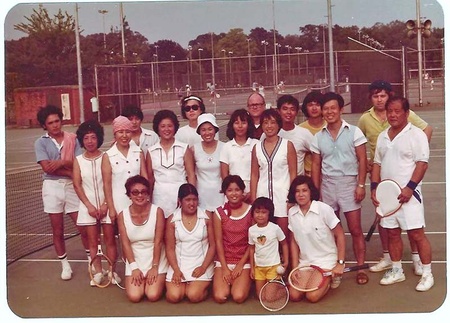
Tennis club c1975.jpg group photo at the City Park tennis courts (New Orleans) of the Japan Club of New Orleans (JCNA) tennis club
Notes:
1. Sakato, M. A brief history of the consulate-general of Japan at New Orleans: A glimpse into relations between New Orleans and Japan. Letter to the Japanese community of New Orleans upon the closing of the Consulate office Nov 9, 2007.
2. Mule M. God, we were at war: Louisianian was in famed Nisei regient. Times Picayune. New Orleans, 1998.
3. Soong T. Club working to preserve touch of Japan. Times Picayune. New Orleans, 1989.
© 2012 Midori Yenari & Anna Stahl




